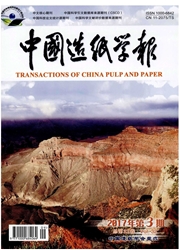

 中文摘要:
中文摘要:
对硫酸盐竹浆包含漆酶/天然介体漂白段的全无氯(TCF)漂白各段的残余木素进行了GPC、TGA、FT—IR、‘H-NMR和”CNMR分析,主要探讨漆酶/天然介体体系(LMS)漂白的机理。分析表明,随漂白的进行,竹浆残余木素的总体变化趋势为分子质量降低;经LMS处理后,竹浆残余木素的热稳定性变差,更易在较低温度下热解;竹浆木素为GSH型,结构单元以G为主,苯丙烷单元之间的连接以β-O-4’为主,此外还有β-1’和β-5’连接。原浆木素中的羟基以酚羟基为主,苯丙烷单元中S的含量(以物质的量计,下同)少于1/3;0段残余木素中,脂肪族羟基比酚羟基多,且有少量-COOH、-0CH3被脱除,苯丙烷单元中G〉H〉S;LMS段残余木素中的羟基以脂肪族羟基为主,S单元含量增加,H单元含量减少,β-1’连接增加,β-5’连接很少。
 英文摘要:
英文摘要:
In this paper, bamboo pulps were bleached with the sequence of oxygen deligninfication (O), laccase and natural mediator system bleaching (LMS), chelating treatment (Q) and hydrogen peroxide bleaching (P). Then, the residual lignins in the TCF bleached pulp were characterized by using GPC, TGA, FT-IR, 'H-NMR, and 13 C-NMR, in order to study the bleaching mechanism, especially the mechanism of LMS bleaching. The GPC studies showed that the molecular weight of lignin decreased with the bleaching process, while Mw/Mn changed remarkably. The TGA studies showed that the thermal stability of lignin decreased in the bleaching process ; The FF-IR, 1H-NMR, 13 C-NMR studies showed that the lignin type of the bamboo pulp was GSH, the percentage of G unit was higher than that of ( S + H), β-O-4', fl-l' and β-5 'were the linkages of C9, and the main linkage was β-O-4'; There are alphatic OH and aromatic OH in the bamboo lignin; The --OCH3 was removed, benzene was broken, and the percentage of alphatic OH inceased in bleaching; After LMS stage, the percentage of S increased, the percentage of H decreased and the percentage of β-1 ' linkage increased.
 同期刊论文项目
同期刊论文项目
 同项目期刊论文
同项目期刊论文
 期刊信息
期刊信息
